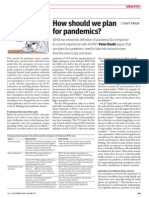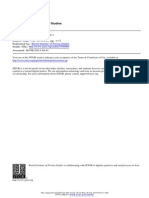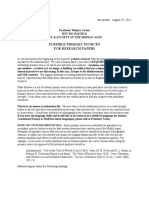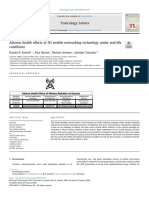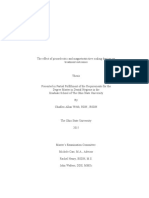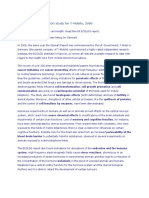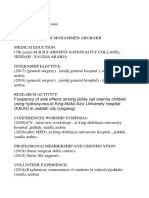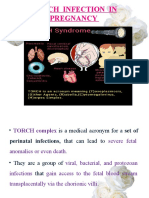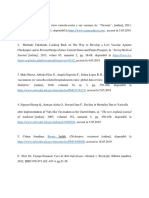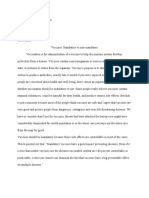-
Professional Documents
-
Culture Documents
The 2 Covid-19 Wave in South Africa: Transmissibility & A 501.V2 Variant
Uploaded by
Bathandwa MalingoOriginal Title
Copyright
Available Formats
Share this document
Did you find this document useful?
Is this content inappropriate?
Report this DocumentCopyright:
Available Formats
The 2 Covid-19 Wave in South Africa: Transmissibility & A 501.V2 Variant
Uploaded by
Bathandwa MalingoCopyright:
Available Formats
The 2nd Covid-19 wave in South Africa:
Transmissibility & a 501.V2 variant
Ministerial Briefing, 18 December 2020
Salim S. Abdool Karim, FRS
Director: CAPRISA
CAPRISA Professor of Global Health, Columbia University
Co-Chair: Ministerial Advisory Committee on COVID-19
Member: African Task Force for Coronavirus
Pro Vice-Chancellor (Research): University of KwaZulu-Natal
Adjunct Professor in Immunology and Infectious Diseases, Harvard University
Adjunct Professor of Medicine: Cornell University
CAPRISA hosts a MRC HIV-TB Pathogenesis
CAPRISA hosts a and Treatment Research Unit
DST-NRF Centre of
Excellence in CAPRISA hosts a DoH-MRC Special Initiative
HIV Prevention CAPRISA is the UNAIDS Collaborating for HIV Prevention Technology
Centre for HIV Research and Policy
Covid-19 in South Africa
7-day moving average of new cases, sentinel hospital admissions and
Covid-19 deaths – to 17 Dec
Before lockdown Level 5 doubling: Level 4 doubling: Level 3 doubling – L2 doubling – L1 doubling – L1 doubling (start of 2nd wave) –
Doubling: 2 days 15 days 12 days Jun- 16 Aug: 25 days 17 Aug – 20 Sept: 21 Sept – 28 Nov: 29 Nov – 16 Dec: 102 days
206 days 276 days
14000 3500
7-day moving average of daily cases
13000 Hospital admissions (116,335)
admissions to DATCOV sentinel
7-day moving average of daily
12000 Cases (892,813) 3000
11000
Deaths (24,011)
hospitals and deaths
10000 2500
9000
8000 2000
New cases
7000
Hospital
6000 Admissions 1500
5000
4000 1000
3000
2000 500
1000 Deaths
0 0
02-Jul
09-Jul
16-Jul
23-Jul
30-Jul
07-May
14-May
21-May
28-May
04-Jun
11-Jun
18-Jun
25-Jun
05-Nov
12-Nov
19-Nov
26-Nov
03-Dec
10-Dec
17-Dec
05-Mar
12-Mar
19-Mar
26-Mar
06-Aug
13-Aug
20-Aug
27-Aug
03-Sep
10-Sep
17-Sep
24-Sep
01-Oct
08-Oct
15-Oct
22-Oct
29-Oct
02-Apr
09-Apr
16-Apr
23-Apr
30-Apr
Source of hospital admissions data: Lucille Blumberg and Waasila Jassat – DATCOV, NICD
7-day moving average of national daily cases
per 100,000 population
0
5
10
15
20
25
30
35
40
45
05-Mar
12-Mar
19-Mar
26-Mar
02-Apr
09-Apr
National
Gauteng
Limpopo
16-Apr
Free State
North West
23-Apr
Mpumalanga
Eastern Cape
30-Apr
Western Cape
Northern Cape
KwaZulu-Natal
07-May
14-May
21-May
28-May
04-Jun
11-Jun
18-Jun
25-Jun
02-Jul
09-Jul
16-Jul
23-Jul
30-Jul
06-Aug
13-Aug
20-Aug
27-Aug
03-Sep
10-Sep
17-Sep
24-Sep
01-Oct
08-Oct
15-Oct
22-Oct
29-Oct
05-Nov
12-Nov
19-Nov
26-Nov
03-Dec
10-Dec
17-Dec
Confirmed SARS-Cov-2 cases by province
Gauteng
National
KwaZulu-Natal
Eastern Cape
Western Cape
(7-day moving average cases per 100,000 population – up to 17 December)
7-day moving average of national daily cases
per 100,000 population
0
1
2
3
4
5
01-Nov
02-Nov
03-Nov
04-Nov
05-Nov
06-Nov
07-Nov
08-Nov
09-Nov
10-Nov
11-Nov
12-Nov
13-Nov
14-Nov
15-Nov
16-Nov
17-Nov
18-Nov
19-Nov
20-Nov
21-Nov
22-Nov
23-Nov
24-Nov
25-Nov
26-Nov
27-Nov
Limpopo
Free State
28-Nov
29-Nov
30-Nov
01-Dec
02-Dec
03-Dec
04-Dec
05-Dec
06-Dec
07-Dec
08-Dec
09-Dec
Mpumalanga
10-Dec
Northern Cape
11-Dec
12-Dec
13-Dec
14-Dec
15-Dec
16-Dec
17-Dec
18-Dec
North West
19-Dec
20-Dec
Confirmed SARS-Cov-2 cases by province
(7-day moving average cases per 100,000 population – up to 17 December)
Comparison of SARS-Cov-2 cases in first and
second wave in Western Cape
(7-day moving average cases per 100,000 population – up to 17 December)
40
7-day moving average of national daily cases
Western Cape - second wave Western Cape - first wave
35
Second wave
30
per 100,000 population
25
Latest results: 59/67
20
(88% are the new variant)
First wave
15
10
0
13
17
21
25
29
33
37
41
45
49
53
57
61
65
69
73
77
81
85
89
93
97
1
5
9
101
105
109
113
117
121
125
129
133
137
141
145
149
153
157
161
165
169
173
177
181
185
189
193
197
201
205
Comparison of SARS-Cov-2 cases in first and second
wave in KwaZulu-Natal
(7-day moving average cases per 100,000 population – up to 17 December)
30
7-day moving average of national daily cases
KwaZulu-Natal - first wave KwaZulu-Natal - second wave
25
per 100,000 population
20
15
Second wave
10
First wave
0
13
17
21
25
29
33
37
41
45
49
53
57
61
65
69
73
77
81
85
89
93
97
1
5
9
101
105
109
113
117
121
125
129
133
137
141
145
149
153
157
161
165
169
173
177
181
185
189
193
197
201
205
209
213
217
Expected & actual all-cause deaths during Covid-19
Before lockdown L5 L4 L3 – 1 Jun – 16 Aug L2 - 17 Aug – 20 Sept L1 - 21 Sept
Excess deaths: 210 Excess deaths: -3,714 Excess deaths: -3,894 Excess deaths: 32,809 Excess deaths: 5,132 Excess deaths: 12,116
Covid-19 deaths : 0 Covid-19 deaths: 93 Covid-19 deaths: 667 Covid-19 deaths: 11,483 Covid-19 deaths: 3,854 Covid-19 deaths: 6,314
18000
16000
14000
12000
Recorded deaths
10000
8000
Predicted deaths
Excess deaths COVID-19 deaths Cases
6000
4000
National cases
2000
Source:
0 Bradshaw D, et al
01-Jul
08-Jul
15-Jul
22-Jul
29-Jul
07-Oct
14-Oct
21-Oct
28-Oct
01-Apr
08-Apr
15-Apr
22-Apr
29-Apr
06-May
13-May
20-May
27-May
03-Jun
10-Jun
17-Jun
24-Jun
04-Nov
11-Nov
18-Nov
25-Nov
02-Dec
09-Dec
16-Dec
04-Mar
11-Mar
18-Mar
25-Mar
05-Aug
12-Aug
19-Aug
26-Aug
02-Sep
09-Sep
16-Sep
23-Sep
30-Sep
5 Mar – 31 May: 7,608 less deaths (all-causes) than expected, mostly from fewer non-natural deaths
1 Jun – 16 Aug: 32,809 excess deaths (all-causes) - 11,483 reported Covid-19 deaths
The fine balance between virus and host
• Viruses usually evolve to become more transmissible & less
severe (less pathogenic or less lethal)
• Mostly within humans in response to immune pressure
• Sometimes when they pass through another species
• SARS-CoV-2 relatively stable in 1st wave – SA recorded about
35 lineages (most were the more transmissible D614G variant
from Europe with minor variations)
• 2nd wave now in all provinces with some early signs of it
spreading faster than 1st wave
• Not clear if 2nd wave has more or less deaths (severity unclear)
2nd wave – new 501.V2 variant with 3 RBD
mutations has spread & become predominant
Probably originated in NMB – spread
3 RBD mutations: K417N, E484K, N501Y to EC, Garden route, KZN & Cape Town
- ↑ affinity to ACE2 receptor & potential Ab escape
Source: Tyler N et al, Cell 2020
Preliminary results:
501.V2 variant associated with higher viral load
Speculate the following:
• Higher viral load in swabs may translate to
higher efficiency of transmission ie. Higher
transmissibility
• This may translate into a higher R0
• While other viruses are transmitting, this
variant is transmitting faster
• This may translate into a 2nd wave that will
have many more cases than 1st wave
What do & don’t we know about the 501.V2 variant?
1. Unusual for a new variant to contain several mutations – 3 in
RBD incl. N501Y – which alters ACE2 affinity & ?Ab effects
2. N501Y is being reported in other countries (0.2%) e.g. UK
3. Early signs that the new variant is spreading fast –
sometimes faster than 1st wave viruses
4. It is widespread – probably across most of SA by now
1. Where did it come from & why did it form? Why NMB? – we
have a few hypotheses to investigate
2. Is it more severe? – to early to tell
3. Is it re-infecting people who got infected in the 1st wave
4. Will the current vaccines work against this variant?
– currently being studied by KRISP, AHRI, NICD & CAPRISA
What should we do next?
1. There is reason for concern that we have a virus that seems
to be spreading rapidly; but it is something we can deal with.
2. Same prevention measures & treatment work for 501.V2
3. Similar 501 variants are in other countries e.g. Australia, UK
4. Inform key role-players & the public about the 501.V2 variant
5. Publish the data in a prominent journal
6. Urgently increase phylogenetic screening – need to
sequence 100-200 viruses every month from across SA
7. Complete the studies to answer the 4 unknowns –
fortunately, there are vaccine trials underway in SA e.g. J&J
You might also like
-
Update On Variant - 18 Jan 2021Document 32 pagesUpdate On Variant - 18 Jan 2021Molefe SeeletsaNo ratings yet
-
Transforming India's biotech sector through Global Bio-India 2021Document 2 pagesTransforming India's biotech sector through Global Bio-India 2021nilanjan1969No ratings yet
-
Geoengineering The ClimateDocument 98 pagesGeoengineering The ClimateAntonioAmishNo ratings yet
-
Nano EthicsDocument 3 pagesNano EthicsSharmaine TolentinoNo ratings yet
-
KUMPULAN BUKU DIGITAL TENTANG “NANODocument 14 pagesKUMPULAN BUKU DIGITAL TENTANG “NANOMimi Rekha ArdithaNo ratings yet
-
FF12 Walkthrough DetailsDocument 93 pagesFF12 Walkthrough DetailsLeong ChunHungNo ratings yet
-
Ai DabusDocument 8 pagesAi DabusADITYAROOP PATHAKNo ratings yet
-
The Mathematics Community and The NSADocument 3 pagesThe Mathematics Community and The NSALeakSourceInfoNo ratings yet
-
Opinion Opinion: We Must Do SomethingDocument 1 pageOpinion Opinion: We Must Do SomethingJamie L. BridgesNo ratings yet
-
Wiki Link Blueprint Link ListDocument 11 pagesWiki Link Blueprint Link ListAlina Iftimie-GrosuNo ratings yet
-
Three-Dimensional Sound Source Localization UsingDocument 15 pagesThree-Dimensional Sound Source Localization UsingWill D'Andrea FonsecaNo ratings yet
-
Additive Manufacturing Using Selective Electron Beam MeltingDocument 8 pagesAdditive Manufacturing Using Selective Electron Beam MeltingHiki ChannelNo ratings yet
-
Report-Public Understanding of Geoengineering 10-24-11Document 9 pagesReport-Public Understanding of Geoengineering 10-24-11Tara AlvaradoNo ratings yet
-
SKA PROGRESSDocument 16 pagesSKA PROGRESSpirotteNo ratings yet
-
CRT InformationDocument 5 pagesCRT InformationA CNo ratings yet
-
Covid-19 Dan Peluang Bioteknologi Dalam MenghadapinyaDocument 14 pagesCovid-19 Dan Peluang Bioteknologi Dalam MenghadapinyaYohana pesta100% (1)
-
Pcast Biodefense Letter Report FinalDocument 19 pagesPcast Biodefense Letter Report FinalAnonymous 6OPLC9UNo ratings yet
-
4936-Assist Gas Flow Chart For LasersDocument 1 page4936-Assist Gas Flow Chart For LasersMinh Nguyen TuanNo ratings yet
-
European Union Map PDFDocument 2 pagesEuropean Union Map PDFTammyNo ratings yet
-
Economic Vision 2030 Full VersionDocument 146 pagesEconomic Vision 2030 Full VersionSaamNariman100% (3)
-
Nanotechnology in Processors and Nokia MorphDocument 36 pagesNanotechnology in Processors and Nokia MorphAvinash SinghNo ratings yet
-
Etc GunDocument 30 pagesEtc GunjobseekeramatxNo ratings yet
-
Python For SeismologyDocument 4 pagesPython For SeismologyKanita Nur IzzatiNo ratings yet
-
Letter To The Federal Government Asking For Increased Access and Accessibility To RemdesivirDocument 9 pagesLetter To The Federal Government Asking For Increased Access and Accessibility To RemdesivirThe Salt Lake TribuneNo ratings yet
-
Unilateral Geoengineering Risks Constraining DeploymentDocument 14 pagesUnilateral Geoengineering Risks Constraining Deployment123strawberryNo ratings yet
-
The Truth in Small DosesDocument 85 pagesThe Truth in Small DosesNational Press FoundationNo ratings yet
-
Energy Gap Investigation and Characterization of Kesterite Cu2znsns4 Thin Film For Solar Cell ApplicationsDocument 4 pagesEnergy Gap Investigation and Characterization of Kesterite Cu2znsns4 Thin Film For Solar Cell ApplicationsInternational Jpurnal Of Technical Research And Applications100% (1)
-
How Should We Plan For Pandemics?Document 3 pagesHow Should We Plan For Pandemics?Jose LopezNo ratings yet
-
Cyrus the Great and the Winged Guardian Figure at PasargadaeDocument 22 pagesCyrus the Great and the Winged Guardian Figure at PasargadaePortoInfernoNo ratings yet
-
İfyil 2017 Presentation EnglishDocument 36 pagesİfyil 2017 Presentation EnglishDanSailaNo ratings yet
-
HST 362 Sources 2011 PDFDocument 27 pagesHST 362 Sources 2011 PDFLéo LacerdaNo ratings yet
-
Disk Management From The Command-Line, Part 1 - The InstructionalDocument 10 pagesDisk Management From The Command-Line, Part 1 - The Instructionalscribd-123No ratings yet
-
COVID 19 Drug Therapy - Mar 2020 PDFDocument 12 pagesCOVID 19 Drug Therapy - Mar 2020 PDFJean-Michel Tommy Luzayamo100% (1)
-
MT Nardi Wildlife Report To UNESCO - FINALpdfDocument 39 pagesMT Nardi Wildlife Report To UNESCO - FINALpdfEmf Refugee50% (2)
-
High Voltage Technology-1Document 19 pagesHigh Voltage Technology-1shamsNo ratings yet
-
Gas LasersDocument 4 pagesGas LasersPayal SinghalNo ratings yet
-
Adverse Health Effects of 5G Mobile Networking Technology Under Real-Life ConditionsDocument 6 pagesAdverse Health Effects of 5G Mobile Networking Technology Under Real-Life ConditionsJessica Learmond-CriquiNo ratings yet
-
Herbicide Tolerance and GM CropsDocument 44 pagesHerbicide Tolerance and GM CropsUğur ÖzkanNo ratings yet
-
The Effect of Piezoelectric and Magnetostrictive Scaling DevicesDocument 38 pagesThe Effect of Piezoelectric and Magnetostrictive Scaling Devicesnotaden1849No ratings yet
-
WS 37 ToxicPlants08Document 28 pagesWS 37 ToxicPlants08anarcopunk100% (1)
-
Qdots Quantum DotsDocument 4 pagesQdots Quantum DotsIndependz1No ratings yet
-
Glyphosate Iarc MonographsDocument 92 pagesGlyphosate Iarc MonographsGabriel AlessioNo ratings yet
-
Liquidbits v. HashFast / Emergency Interim Order No. 1 - ArbitrationDocument 12 pagesLiquidbits v. HashFast / Emergency Interim Order No. 1 - ArbitrationArs TechnicaNo ratings yet
-
Livermore Labs - From Video To KnowledgeDocument 8 pagesLivermore Labs - From Video To KnowledgeLeakSourceInfoNo ratings yet
-
LaserDocument 21 pagesLaserJisha Mariam JoseNo ratings yet
-
CST Charged Particle Simulation LowDocument 2 pagesCST Charged Particle Simulation Low9999igi100% (1)
-
Connecting Business Principles and the SDGsDocument 12 pagesConnecting Business Principles and the SDGsHaddadAkremNo ratings yet
-
Parashah 15 - Bo (Go)Document 11 pagesParashah 15 - Bo (Go)HaSophimNo ratings yet
-
Risk Assessment Template - Photo StudioDocument 2 pagesRisk Assessment Template - Photo StudioSian AustinNo ratings yet
-
AFC's Combat Capabilities Development Command Supports National COVID-19 ResponseDocument 4 pagesAFC's Combat Capabilities Development Command Supports National COVID-19 ResponseBreakingDefenseNo ratings yet
-
10.20.21 FL SS HandoutDocument 1 page10.20.21 FL SS HandoutWCTV Digital Team0% (1)
-
The Geoengineering OptionDocument 14 pagesThe Geoengineering Option911lieNo ratings yet
-
Ecolog Report For T Mobile 2000Document 2 pagesEcolog Report For T Mobile 2000Jessica Learmond-CriquiNo ratings yet
-
Dr. Robert J. Rowen - Posts 5G Technology & Induction of Coronavirus in Skin CellsDocument 1 pageDr. Robert J. Rowen - Posts 5G Technology & Induction of Coronavirus in Skin CellsNemo Nemo100% (1)
-
COVID-19 May 14Document 15 pagesCOVID-19 May 14Patch MinnesotaNo ratings yet
-
COVID-19 Pandemic: A Review of The Global Lockdown and Its Far-Reaching EffectsDocument 18 pagesCOVID-19 Pandemic: A Review of The Global Lockdown and Its Far-Reaching Effectsnanthini kanasanNo ratings yet
-
WHO Case Management UpdateDocument 25 pagesWHO Case Management UpdateadeNo ratings yet
-
4 Slaughterhouse Respiratory Check (SRC) and Its Applicability To Defend Ceva S Vaccines - Field Examples PDFDocument 27 pages4 Slaughterhouse Respiratory Check (SRC) and Its Applicability To Defend Ceva S Vaccines - Field Examples PDFAnastasia DivaNo ratings yet
-
General Practice Doctor CV and ContactDocument 2 pagesGeneral Practice Doctor CV and ContactNour AbobakerNo ratings yet
-
Short Covid-19 Dialog 1Document 3 pagesShort Covid-19 Dialog 1karin kamilaNo ratings yet
-
Steps in Undertaking Preliminary Investigation: 1.) Screening TestsDocument 2 pagesSteps in Undertaking Preliminary Investigation: 1.) Screening TestsApril Rose SalvadicoNo ratings yet
-
Medicinal Chemistry of Antiviral Drugs Immunosuppressant, Immunostimulant Neurodegenerative DiseaseDocument 32 pagesMedicinal Chemistry of Antiviral Drugs Immunosuppressant, Immunostimulant Neurodegenerative DiseaseHarshe PraveenNo ratings yet
-
Virus FlowchartDocument 1 pageVirus FlowchartMatthiasX12100% (1)
-
Respiratory SyncytialDocument 32 pagesRespiratory Syncytialtummalapalli venkateswara rao100% (1)
-
Cordia Viral MeningitisDocument 7 pagesCordia Viral MeningitisAyuagung Chandra Maha DewiNo ratings yet
-
CertificateDocument 1 pageCertificatefirebase fbNo ratings yet
-
General Structure and Classification of Viruses 4Document 50 pagesGeneral Structure and Classification of Viruses 4OROKE JOHN EJE100% (1)
-
Differences between Virus, Viroid, Phytoplasma, Spiroplasma and Satellite ElementsDocument 10 pagesDifferences between Virus, Viroid, Phytoplasma, Spiroplasma and Satellite ElementsMuhammad AzamNo ratings yet
-
Herpes Zoster!Document 26 pagesHerpes Zoster!Ruth Faustine Jontah Rayo100% (1)
-
Veterinarian Houston HeightsDocument 4 pagesVeterinarian Houston HeightstanosidagenNo ratings yet
-
Department of Education: Republic of The PhilippinesDocument 10 pagesDepartment of Education: Republic of The PhilippineskayerencaoleNo ratings yet
-
Nanotechnology-Based Antiviral TherapeuticsDocument 40 pagesNanotechnology-Based Antiviral TherapeuticsGabrielNo ratings yet
-
Torch InfectionsDocument 27 pagesTorch InfectionsSimi SaiPrasoonNo ratings yet
-
Human Immunodeficiency Virus LectureDocument 34 pagesHuman Immunodeficiency Virus Lectureapi-19969058No ratings yet
-
MrASHISHDUBEY 29Y MaleDocument 2 pagesMrASHISHDUBEY 29Y MaleNisha DubeyNo ratings yet
-
A - Riki Satya - Final ExamDocument 1 pageA - Riki Satya - Final ExamrikiNo ratings yet
-
Some Behavioral and Legal Considerations While Travelling To AustraliaDocument 2 pagesSome Behavioral and Legal Considerations While Travelling To AustraliaRafael ValderramaNo ratings yet
-
Fernando - Sico - Elo - (181111010) Bahasa InggrisDocument 2 pagesFernando - Sico - Elo - (181111010) Bahasa InggrisAsicoNo ratings yet
-
Antiviral ChemotherapyDocument 11 pagesAntiviral ChemotherapyAsmaa HwaidNo ratings yet
-
Science - July 8, 2022 USADocument 144 pagesScience - July 8, 2022 USASimej100% (1)
-
African Swine Fever: Now in WidespreadDocument 2 pagesAfrican Swine Fever: Now in WidespreadMariaGlenda Dellosa Guevara-YusonNo ratings yet
-
Egg Inoculation Techniques: Dr. R. KalaimathiDocument 53 pagesEgg Inoculation Techniques: Dr. R. Kalaimathiprakyy2kNo ratings yet
-
Virology Micro D&R AgamDocument 142 pagesVirology Micro D&R AgamNirosha ArulNo ratings yet
-
Hepatitis ADocument 11 pagesHepatitis AIGA ABRAHAMNo ratings yet
-
Review of Companion Animal Vaccine and ImmunoprophylaxisDocument 14 pagesReview of Companion Animal Vaccine and ImmunoprophylaxisVictor FelterNo ratings yet
-
Aranjarea BibliografieiDocument 12 pagesAranjarea BibliografieialinaNo ratings yet
-
Argumentative Essay FinalDocument 5 pagesArgumentative Essay Finalapi-549770007No ratings yet
-
1) About The Pandemic COVID-19Document 2 pages1) About The Pandemic COVID-19محسين اشيكNo ratings yet
-
Notes On Medical Virology What You Really Need To KnowDocument 37 pagesNotes On Medical Virology What You Really Need To KnowMilyas100% (1)



























